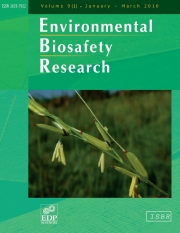Article contents
Three-dimensional prediction of maize pollen dispersal andcross-pollination, and the effects of windbreaks
Published online by Cambridge University Press: 13 August 2010
Abstract
With the extensive adoption of transgenic crops, an understanding of transgene flow isessential to manage gene flow to non-GM crops. Thus, a flexible and accurate numericalmodel is required to assess gene flow through pollen dispersal. A three-dimensionalatmospheric model combined with a diffusion transport model would be a useful tool forpredicting pollen dispersal since it would be flexible enough to incorporate the effectsof factors such as the spatial arrangement of crop combinations, land use, topography,windbreaks, and buildings. We applied such a model to field measurements of gene flowbetween two adjacent maize (Zea mays) cultivars, with suppression effectsdue to windbreaks, in an experimental cornfield in Japan. This combined model reproducedthe measured cross-pollination distribution quite well in the case of maize plots withplant windbreaks slightly taller than the maize and without windbreaks, but the modelunderestimated the effect of a 6-m-tall windbreak net beyond 25 m from the donor pollensource on cross-pollination. The underestimation was most probably due to the problem ofassimilated wind data. The model showed that the 6-m-tall windbreak and the plant windbreak suppressed average cross-pollination rate by about 60% and 30%, respectively.Half-tall and coarser mesh windbreak net suppressed cross-pollination rates by 40% byreducing the swirl of donor pollen by reduced wind speed.
Information
- Type
- Research Article
- Information
- Copyright
- © ISBR, EDP Sciences, 2010
References
- 11
- Cited by

